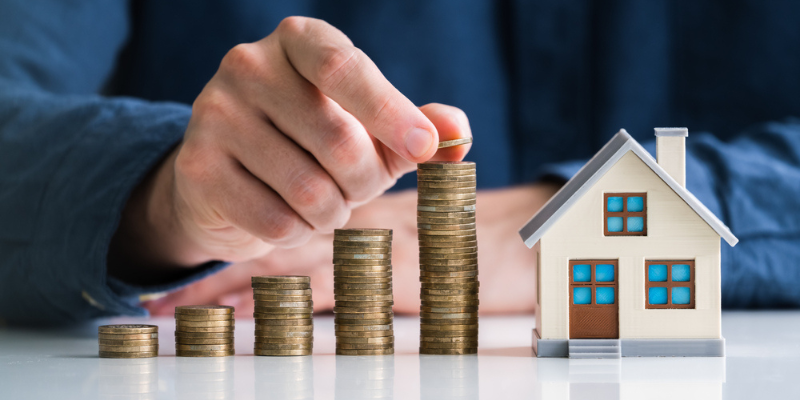Unfortunately, every state charges property tax, but the rates vary. Hawaii has the lowest effective property tax rate at 0.32%, while New Jersey has the highest at 2.23%.
What Are Property Taxes?
Every homeowner in the United States must pay taxes on any property they own. The average homeowner pays $2,690 per year in property tax, with an average rate of 1.10%.
Property taxes are an important expense for homeowners because they are one of the few costs that can change throughout the life of a mortgage. Your house payment stays the same each month, but property taxes differ based on where you live.
If a homeowner in Hawaii suddenly experienced the same property tax rate as New Jersey, an owner with a $500,000 property would end up paying an extra $9,500 per year! This is unlikely, but it demonstrates how much tax rate can affect the costs of owning a home
How are Property Taxes Calculated?
To calculate property taxes, simply take the assessed value of the house and multiply it by the local property tax rate.
Consider a $1,000,000 home in California, taxed at 0.75%. Multiply 1,000,000 by .0075 to get $7,500. Divide by 12 to get a monthly cost of $625.
The house’s assessed value is determined by the county assessor, who determines a fair market value for every property in their jurisdiction. In theory, the fair market value determined by the assessor should be the same as what the property would sell for if listed.
Effective Property Tax Rate
There isn’t actually a set tax rate per state, as it’s generally set by local entities to help cover necessary operating costs. These taxes help fund schools, libraries, roads, emergency services, and more.
Once a total annual budget is determined to fund everything, they divide that by the total market value of all properties in their jurisdiction and come up with a tax rate.
When discussing the tax rate for an entire state, that isn’t what everyone is actually paying. It’s calculated by taking the total amount paid in taxes divided by the total market value of all properties in the state. This is called the effective tax rate.

Property Tax Rate By State
| Rank | State | Effective PropertyTax Rate |
| 1 | New Jersey | 2.23% |
| 2 | Illinois | 2.08% |
| 3 | New Hampshire | 1.93% |
| 4 | Vermont | 1.83% |
| 5 | Connecticut | 1.79% |
| 6 | Texas | 1.68% |
| 7 | Nebraska | 1.63% |
| 8 | Wisconsin | 1.61% |
| 9 | Ohio | 1.59% |
| 10 | Iowa | 1.52% |
| 11 | Pennsylvania | 1.49% |
| 12 | New York | 1.40% |
| 13 | Rhode Island | 1.40% |
| 14 | Michigan | 1.38% |
| 15 | Kansas | 1.34% |
| 16 | Maine | 1.24% |
| 17 | South Dakota | 1.17% |
| 18 | Massachusetts | 1.14% |
| 19 | Minnesota | 1.11% |
| 20 | Maryland | 1.05% |
| 21 | Alaska | 1.04% |
| 22 | Missouri | 1.01% |
| 23 | North Dakota | 0.98% |
| 24 | Oregon | 0.93% |
| 25 | Georgia | 0.92% |
| 26 | Florida | 0.91% |
| 27 | Oklahoma | 0.89% |
| 28 | Virginia | 0.87% |
| 29 | Washington | 0.87% |
| 30 | Indiana | 0.84% |
| 31 | Kentucky | 0.83% |
| 32 | North Carolina | 0.82% |
| 33 | California | 0.75% |
| 34 | Montana | 0.74% |
| 35 | New Mexico | 0.67% |
| 36 | Mississippi | 0.67% |
| 37 | Tennessee | 0.67% |
| 38 | Idaho | 0.67% |
| 39 | Arkansas | 0.64% |
| 40 | Arizona | 0.63% |
| 41 | Washington D.C. | 0.62% |
| 42 | Delaware | 0.61% |
| 43 | Nevada | 0.59% |
| 44 | Utah | 0.57% |
| 45 | West Virginia | 0.57% |
| 46 | South Carolina | 0.57% |
| 47 | Louisiana | 0.56% |
| 48 | Wyoming | 0.56% |
| 49 | Colorado | 0.55% |
| 50 | Alabama | 0.40% |
| 51 | Hawaii | 0.32% |
How Taxes Affect Rental Property Owners
Most rental property owners focus on monthly cash flow over everything else. However, it’s not always easy to predict monthly costs. There are some fixed costs, but the mortgage payment is the big expense that stays the same throughout the entire life of the mortgage.
Some costs are truly variable month-to-month, such as repairs and utilities. Other costs are locked in for a period of time but will usually increase over time—such as property taxes.
For example, as the property increases in value, your taxes go up. If the tax rate increases, you also are on the hook for a larger bill.
As a rental property owner, setting aside extra money each month for unexpected costs is essential. However, it’s also important to consider if there’s enough margin to cover a yearly raise in property taxes.
Ideally, you’ll be able to continue raising rent to cover the cost of increasing taxes, but there’s no guarantee. This is one way a slim monthly margin could turn into negative cash flow.

